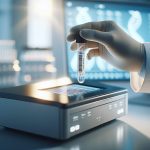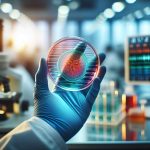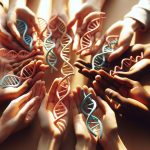Colorectal cancer stands out as one of the cancers that can most effectively be prevented. When caught in its early stages, the chances of surviving it are incredibly high, exceeding a 90% survival rate. Despite this, it remains the second most fatal cancer in the United States. A conversation with Atul Sharan, who heads CellMax Life, sheds light on their pioneering efforts in combatting this disease. CellMax Life is at the forefront of cancer diagnostic technology, championing a revolutionary approach to cancer detection and management through their easy-to-use and accessible tests. Their goal is straightforward: make early detection of cancer not just possible but practical for everyone around the globe, thereby altering the course of how we diagnose and manage this menacing disease.
Origin and Development of CellMax Life
As we get older, the risk of encountering cancer becomes almost inevitable. This might seem a bit shortsighted considering the vast array of infectious diseases out there, notably the coronavirus pandemic that has swept across the globe. However, while infections may ebb and flow, cancer remains a steadfast threat. This reality hit home for me through personal experiences; my mother succumbed to esophageal cancer after a late diagnosis, and more recently, my wife’s mammogram threw up some concerning signs despite initially testing negative for breast cancer.
Breast cancer awareness is high and advocacy strong, yet mammograms aren’t always effective in detecting it early on, particularly in women with dense breast tissue. Despite her doctor’s reassurances post-mammogram, something didn’t sit right with me. Given my involvement at Artiman Ventures, a venture capital firm focused on early cancer detection technologies among other ventures based in Silicon Valley, I insisted on additional imaging for my wife. Just two weeks after her clear mammogram result came back negative came the jarring diagnosis of early-stage breast cancer.
The stark truth about fighting this disease is that catching it early—before it can spread—is essentially our only shot at a cure that involves completely removing the tumor surgically. Symptoms often remain hidden until it’s far too late making preemptive strikes against this malady all the more critical. That’s why there’s such an urgent need for accessible tests capable of identifying cancers early on—a challenge we were keen to address.
Cancer knows no borders; its impact is felt worldwide regardless of a country’s economic status or healthcare infrastructure which makes finding universal solutions imperative. While stationed at Artiman Ventures, I was part of an initiative aimed at tackling this global issue head-on through innovative technology.
Our team eventually coalesced around this mission leading us to establish operations both within the US and abroad—specifically Taiwan where Professor Ying-Chang (my co-founder who previously conducted research at Stanford) happened to have relocated earlier. Together we set up labs in both countries as stepping stones towards creating advancements in early cancer detection that could potentially revolutionize how we approach treating this pervasive disease globally.
What sets CellMax Life apart from other diagnostic firms?
To truly understand whether someone has cancer, doctors often need to take a small sample of tissue from the body, a process known as a biopsy. Though many procedures and scans can suggest the presence of cancer, a biopsy is usually necessary to confirm it. However, advancements in technology have introduced an innovative method called liquid biopsy for detecting cancer DNA early on.
This novel approach takes advantage of how tumors behave. As they grow, tumors release cells into the bloodstream and surrounding areas. These are not ordinary cells; they’re abnormal and usually targeted by our immune system for destruction. As these cells navigate through the blood, they release tumor DNA, the very genetic material that could indicate the presence of cancer.
Our focus is on catching these rogue cells alongside tumor DNA. While some companies concentrate solely on finding circulating tumor DNA (ctDNA) using existing technology like Illumina’s next-generation sequencing, we’ve taken it a step further. We’re chasing after those one-in-a-billion cells that are incredibly elusive yet highly indicative of early-stage cancer.
To do this effectively, we’ve had to innovate from scratch. We developed an entirely unique platform with tools specifically designed for this purpose: from bio-mimetic techniques that mimic biological processes to interdisciplinary approaches combining various fields of study. Our toolkit includes custom-made microfluidic chips coated with proprietary antibodies—a testament to our commitment to pioneering in early cancer detection.
In essence, what sets us apart is our ability to detect both rare circulating tumor cells and tumor DNA through our exclusive technology platform – offering hope for earlier diagnosis when treatment might be most effective.
Explaining Our Testing Process
When patients come to us, they undergo what appears to be a routine procedure where we draw blood. This sample is then split into two distinct parts for analysis. The first part goes through our specialized system designed to identify specific cells, while the second part undergoes analysis via Illumina next-generation sequencing technology. This advanced method helps us scout for any genetic mutations that could indicate disease.
Our focus has been mainly on battling colon cancer right from its onset stages. What sets our approach apart is our ability to identify the precancerous stage known as polyps or clinically referred to as adenomas. Traditional methods such as colonoscopies aim to find these polyps; however, our technology allows us to detect these critical changes much earlier than others can.
This early detection capability is groundbreaking because it enables us to catch colon cancer in its tracks before it fully develops. For patients, this means potential lifesaving intervention at a stage when it’s most manageable and less invasive treatments are possible, marking a significant advancement in how we tackle this particular type of cancer.
Can anyone access your testing, or must it be done via a healthcare provider?

Striving to bring testing within easy reach of all, our mission is crystal clear. In Asian nations where out-of-pocket payment is the norm, we’ve taken a hands-on approach by offering various tests directly to consumers through our laboratory in Taiwan. However, the landscape shifts dramatically once we talk about the United States. Here, navigating the market for direct-to-consumer screening tests presents its own set of hurdles; usually, it’s your family doctor who ends up recommending these screenings.
Our strategy for carving out a space in the American market hinges on securing FDA approval first and foremost. Following this crucial step, we plan to foster collaborations with general practitioners. This move not only aligns with regulatory expectations but also ensures that patients receive comprehensive care. By partnering with healthcare professionals right from the get-go, we’re setting ourselves up for success and ensuring that more individuals have access to essential health screenings.
Comparing the precision of blood tests with conventional methods like Colonoscopies for detecting Colorectal cancer
Screening for various types of cancer employs distinct methods. For instance, mammograms are used to detect breast cancer, while colonoscopies target colon cancer. Lung and prostate cancers have their own specific screenings through low-dose CT scans and PSA tests respectively. However, not all cancers have traditional screening procedures in place.
The goal behind a new blood test is to surpass the effectiveness of current non-invasive screenings. Specifically, in the context of colon cancer, where the primary method has been colonoscopy – a procedure designed originally not for screening but for removing polyps and tumors due to the absence of a non-invasive alternative that could identify such growths effectively. Despite its utility, a colonoscopy comes with high costs.
This forthcoming test aims to parallel the results of a colonoscopy without intending to replace it outright since physical removal of any detected adenomas or tumors would still necessitate such procedures. Current stool-based screenings fall short as they fail to identify pre-cancerous conditions and often encounter resistance from individuals reluctant to undergo such testing.
Through simplification and innovation in detection methods, this new approach seeks to enhance compliance rates and early detection capabilities without encroaching upon the roles traditional procedures play in treatment processes.
Should DNA tests and studies become a regular part of our health services?
In the pursuit of profit, there’s a noticeable trend in the market pushing for DNA tests that may not be essential. The United States sees an overwhelming array of over 50,000 direct-to-consumer genetic testing options, many of which serve unclear purposes. This surge caters predominantly to a niche group who have both the means and the intellectual curiosity to indulge in such services. However, the practicality of these tests comes into question when individuals present their results to doctors who might not understand or value the data provided due to unfamiliarity with such detailed reports.
This situation highlights how industries can get caught up in an initial frenzy—chasing after novel advancements without fully considering their applicability or utility. Nonetheless, it’s expected that this enthusiasm will temper over time. With gradual understanding and integration, DNA testing is poised to find its rightful place where it truly benefits society by honing in on applications that make a meaningful difference.
Moreover, recent advancements in this field have played a pivotal role in addressing global challenges like COVID-19 more effectively than could have been imagined a few years back. It underscores how technological progress can lead to significant leaps forward when applied judiciously and thoughtfully integrated into our healthcare strategies.
What does the future hold for the industry, and what trends might emerge?
The advent of blood tests for cancer detection marks a thrilling breakthrough in medical science. However, caution is warranted. The main issue lies with the American companies at the forefront of this innovation—they’re banking on substantial reimbursements, which might limit its accessibility globally.
Presently, the buzz surrounding these developments outpaces the actual progress. There’s no denying the enthusiasm is palpable, but a tangible product that becomes a staple in healthcare is still on the horizon. Despite this, there’s optimism that over time, as costs decrease, this technology will be embraced worldwide.
Healthcare in America consumes a significant portion of its GDP—about one-third—highlighting an expenditure other nations cannot mirror. This disparity underscores the need for affordable and universally accessible solutions in cancer screening technologies—an objective that seems achievable as we move forward and costs begin to wane.




















